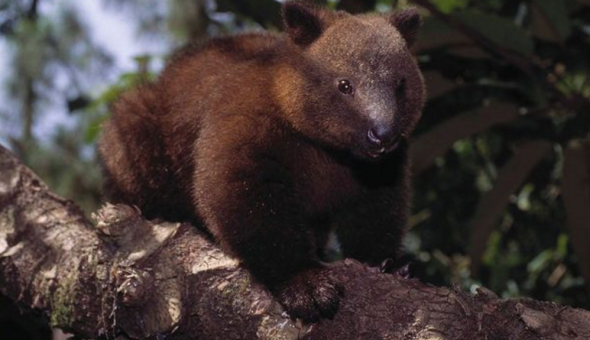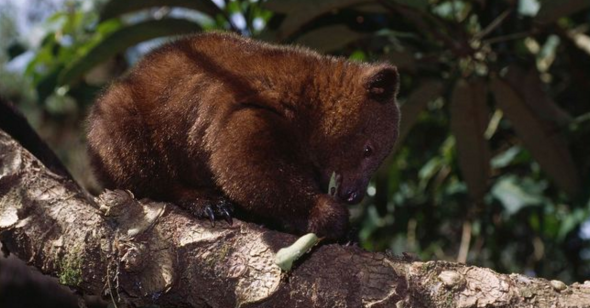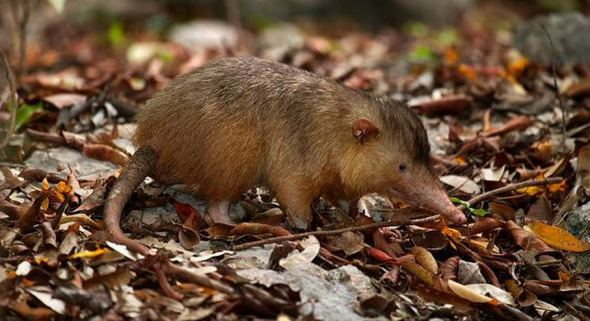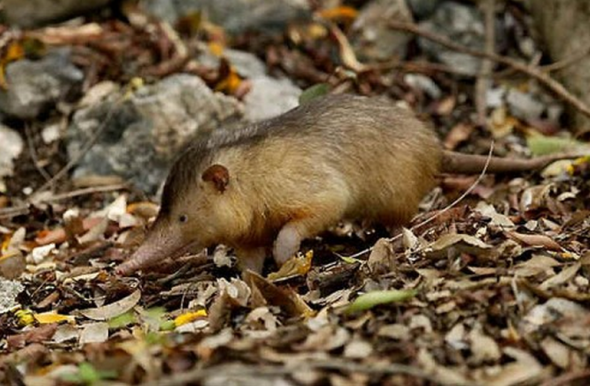Endangered Species Friday: Dendrolagus dorianus | Cuddly Teddy Bear Facing Extinction.
Endangered Species Friday: Dendrolagus dorianus
This Friday’s (Endangered Species Post) [E.S.P] I touch up on this rather unusual species of tree kangaroo that’s rarely mentioned within the world of conservationism. Furthermore I also wish to set the record straight about these wonderful and utterly adorable species of mammals which many people seem to believe are endemic ‘just to Australia’. This particular species is actually native to Papua New Guinea, generically identified as Dendrolagus dorianus. (Image credits: Daniel Heuclin).
Listed as (vulnerable), the species was primarily identified by Dr Edward Pierson Ramsay (3 December 1842 – 16 December 1916). Dr Ramsay was an Australian zoologist who specialized in ornithology. Among organisms Dr Ramsay named are the pig-nosed turtle, giant bandicoot, grey-headed robin and Papuan king parrot.
D. dorianus lives within a country of immense cultural and biological diversity. A country known for its beaches, coral reefs and scuba diving. Not forgetting the countries inland active volcanoes. Locals commonly identify the animal as the; Doria’s tree kangaroo or the unicolored tree kangaroo. Doria’s tree kangaroo is within the order of Diprotodontia, and the family identified as Macropodidae.
Since 1982 to 1994 the species has remained at [vulnerable level] of which back in 1996 a further assessment of the species noted a possible population decline. The decline prompted environmentalists to notch the species further up the list of [vulnerable species]. However a survey in 2008 concluded the species hadn’t as yet qualified for any further threatened status (E.g) endangered (which would unfortunately be the next listing should threats not decline in the wild).
Scientific research and population evaluations have shown a staggering 30% decline of overall wild populations which is quite a large population decrease, although “allegedly not concerning enough as yet to reclassify this particular specimen as endangered”. Yes its unfortunate that the current news relating to (decreasing populations), is indeed factual, and its likely (as explained), that should threats in the wild not decrease anytime soon, we could see a new extinction occurring in as little as ten years “if not sooner”. Populations are not known to be ‘fragmented’.
Image: Rare glimpse of the Doria Tree Kangaroo.
Identified in 1883 there are very few conservation actions actually known that could help increase declining population sizes which I myself find somewhat frustrating, not to mention perplexing, especially when one takes into consideration the current level of threats associated with this specie in Papua New Guinea.
Research proves the species inhabits some several protected national parks [NP’s], unfortunately extreme hunting activities I.e illegal poaching is still ongoing. While Anti Poaching Operations [APU’s] do exist, the fact of the matter is that Cites (The Convention on International Trade of Endangered Species Wild Flora and Fauna), still hasn’t listed the species as (protected or endangered) on either Appendix I or Appendix II.
Image: Extinction may occur in a decade of not sooner.
To date the current population level is unknown, furthermore reproduction is also believed to be incredibly low and poor.
MAJOR THREATS
Known threats relate to the bush meat trade, which if not controlled will unfortunately push the species into extinction. Hunting with dogs, unregulated/illegal hunting is quite high and problematic within the region. Finally the species absolutely hates canines of which when threatened emits depressed vocalizations. Future threats have been identified as habitat loss and degradation.
The Doria’s tree kangaroo lives at elevations of some 600-3,650 meters of which is mostly nocturnal and a solitary animal. Dr Ramsay named the species after Professor Marquis Giacomo Doria (1 November 1840 – 19 September 1913) whom was an Italian naturalist, botanist, herpetologist, and politician of Italy.
Doria’s tree kangaroo is probably one of the largest species of tree kangaroos on the planet, although this is somewhat debatable. Weighing in at 6.5-14.5 kilograms, length is around 60-80 centimeters, with a tail length of some 40-70 centimeters. With a large tail, dense black and brown fur, large powerful claws and stocky build, the appearance of this specific animal almost appears to look like a medium sized bear.
Diet consists of leaves, flowers, fruits and buds, there is no evidence that suggests or points to any form of meat eating either. Gestation period of females is around thirty days, of which the ‘single young baby’ will remain in mothers pouch for around ten months.
There really is limited information about this specific species which could be due to the fact the species is actually very rare, nocturnal, and lives at moderate to high elevations within dense montane forests. I am asking the public to please share this article far and wide to help us push more awareness of this species into the public domain, which we hope will encourage (Cites) to protect the species sooner rather than later.
This article is dedicated to Ms Toni Devine, a wonderful young lady that absolutely adores these wonderful species of animals, who wouldn’t adore them, they are truly remarkable, intelligent, and in way more like cuddly teddy bears.
Chief Environmental & Botanical Officer
Dr Jose C. Depre
Environmental Crimes Investigator
Follow me on Twitter here: https://twitter.com/josedepre11
Follow us on Facebook via clicking the link below:
https://www.facebook.com/InternationalAnimalRescueFoundationAfrica/
Endangered Species Friday: Hispaniolan Solenodon.
Endangered Species Friday: Hispaniolan Solenodon
This Fridays endangered species article we focus on a very peculiar looking animal scientifically named as the Hispaniolan Solenodon pictured above.
Listed as (endangered) the species is endemic to the Dominican Republic and Haiti of which was identified back in 1833 by Dr Johann Friedrich von Brandt (25 May 1802 – 15 July 1879) was a German naturalist.
Dr Brandt was born in Jüterbog and educated at a gymnasium in Wittenberg and the University of Berlin. In 1831 he was appointed director of the Zoological Department at the St Petersburg Academy of Sciences, where he published in Russian. Brandt encouraged the collection of native animals, many of which were not represented in the museum. Many specimens began to arrive from the expeditions of Severtzov, Przhevalsky, Middendorff, Schrenck and Gustav Radde.
At first glance one would be led to believe that the H. solenodon was a type of rodent. The species is in fact a a type of shrew in the family of Solenodontidae identified by Dr Gill in 1872. While they may posses the same characteristics as rodents they do not fall into the super-class of Euarchontoglires that rodents do.
H. solenodon has been classified as (endangered) since early 1982 up to 1996 when a more in depth census undertaken on the species failed to locate any significant evidence of species population increases. To date 29th May 2015 the H. solenodon commonly named as the Haitian Solenodon or Hispaniolan Solenodon remains endangered and is nearing extinction level.
Solenodons which in (Latin means - slotted tooth) are not a creature to be underestimated either as of their pretty nasty venomous bite that does pack a rather large punch. Solenodons are one of very few species of small “rodent like shrews” that’s bite is much worse than its bark.
The solenodon is particularly fascinating because it delivers its poison just as a snake does—using its teeth as a syringe to inject venom into its target. Not a lot is known about these unusual mammals. There are only two solenodon species: One lives on Cuba and the other on Hispaniola (home to Haiti and the Dominican Republic). At night, they dig in the dirt with their Pinocchio snouts and long claws, looking for grub and waiting to disarm their prey—insects, worms, snails and small frogs and reptiles—with a toxic bite.
While their venom is not dangerous to humans we do advise that if handling to please wear a good protective layer of gloves. There have been no reports of humans falling ill or dying from being bitten by a solenodon.
The Haitian solenodon is found in forests and brush country, as well as around plantations. It is mainly nocturnal, hiding during the day in rock clefts, hollow trees, or burrows which it excavates itself. Its diet includes insects and spiders found in soil and leaf litter. Solenodons obtain food by rooting in the ground with their snouts and by tearing into rotten logs and trees with their foreclaws. This species is relatively social, and up to eight individuals may inhabit the same burrow. Litter size is 1 or 2 young. The young are born in a nesting burrow. Young solenodons remain with their mother for several months, which is exceptionally long for insectivores.
Population trends are unfortunately decreasing of which its major threats are listed below for your immediate attention.
Threats
The most significant threat to this species appears to be the continuing demise of its forest habitat and predation by introduced rats, mongoose, cats and dogs, especially in the vicinity of settlements. In Haiti persecution and hunting for food (Samuel Turvey pers. comm.) is a threat, and there is devastating habitat destruction also occurring.
Please view the video below for further information.
Thank you for reading
Dr Jose C. Depre
Chief Environmental & Botanical Officer.
Chief Executive
International Animal Rescue Foundation Africa.








